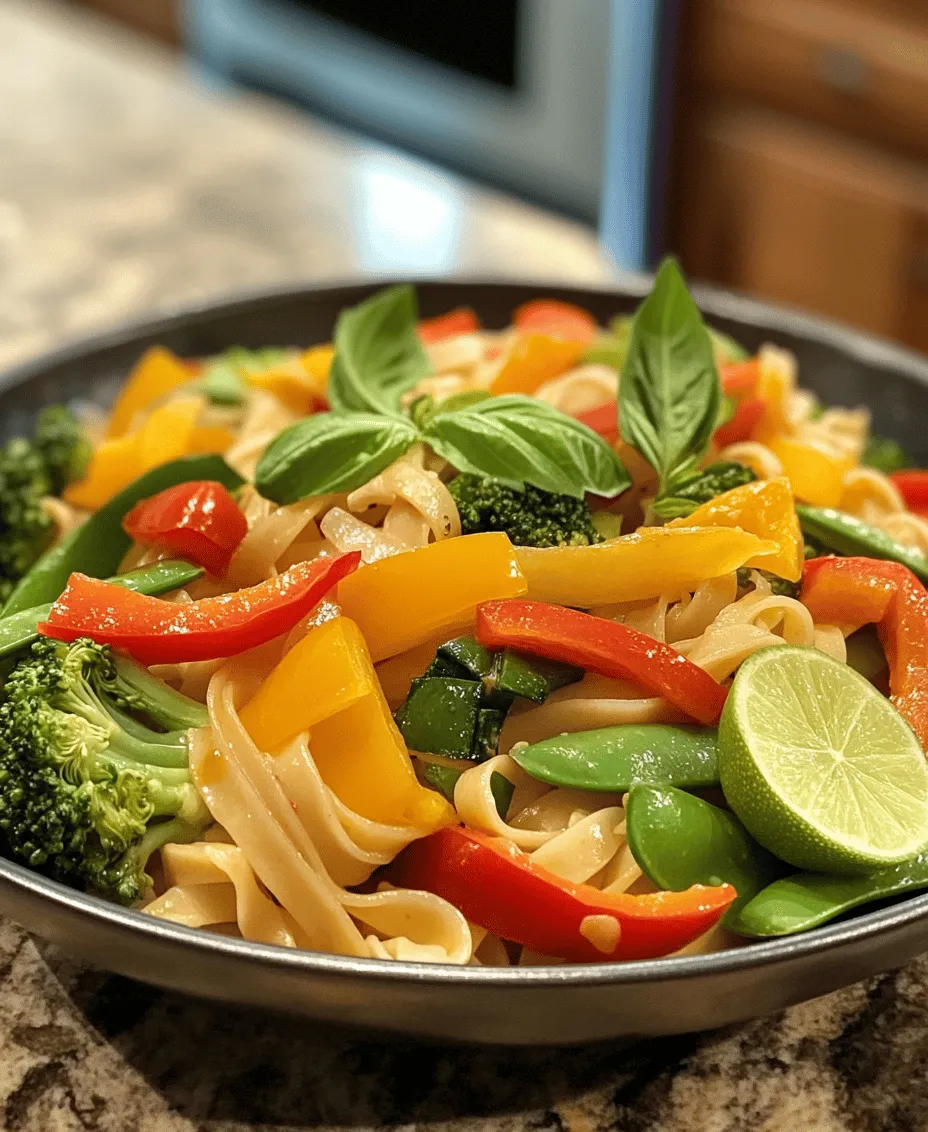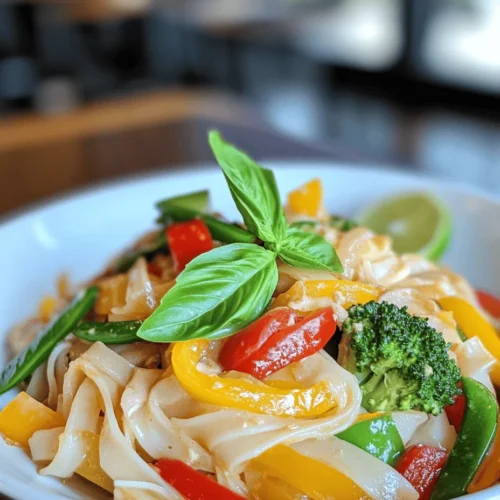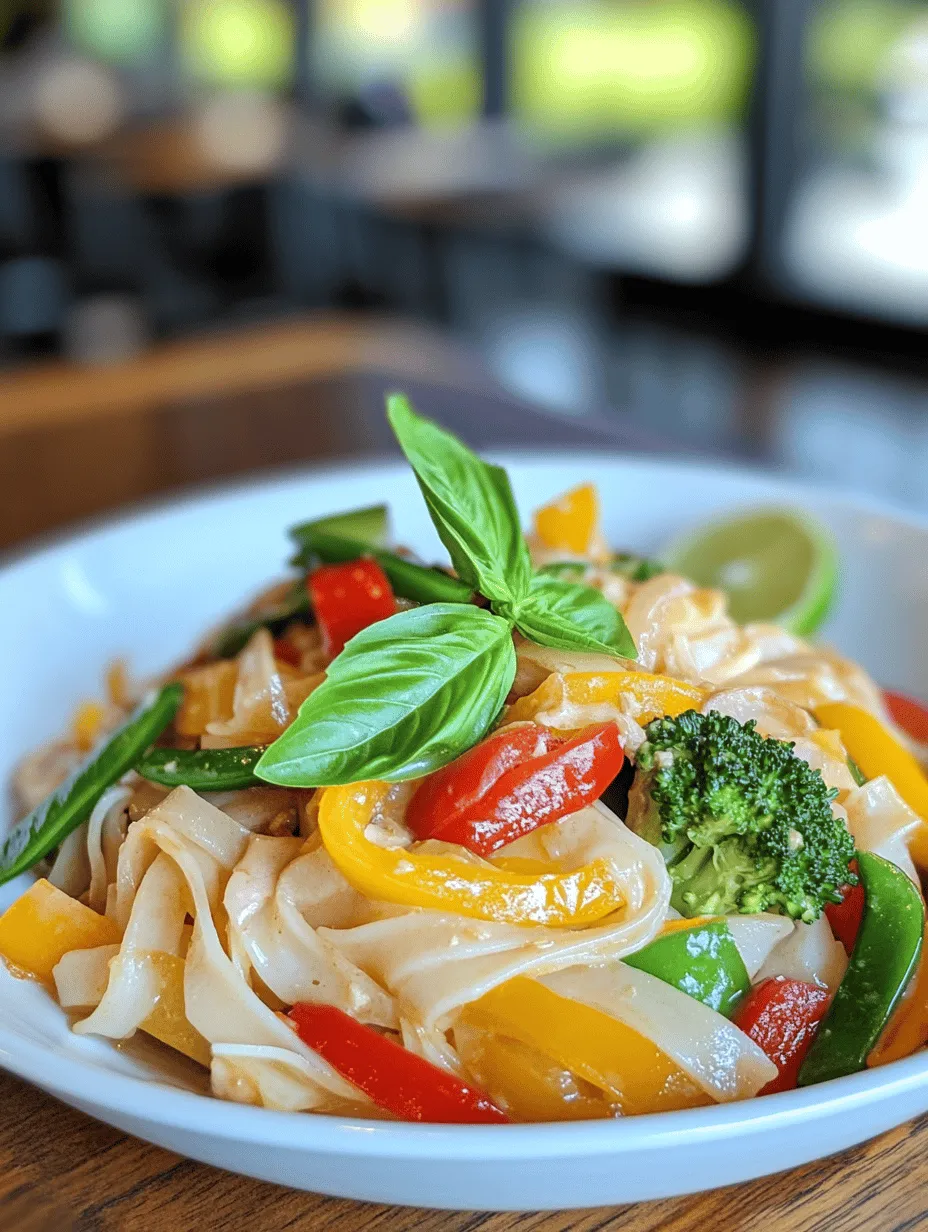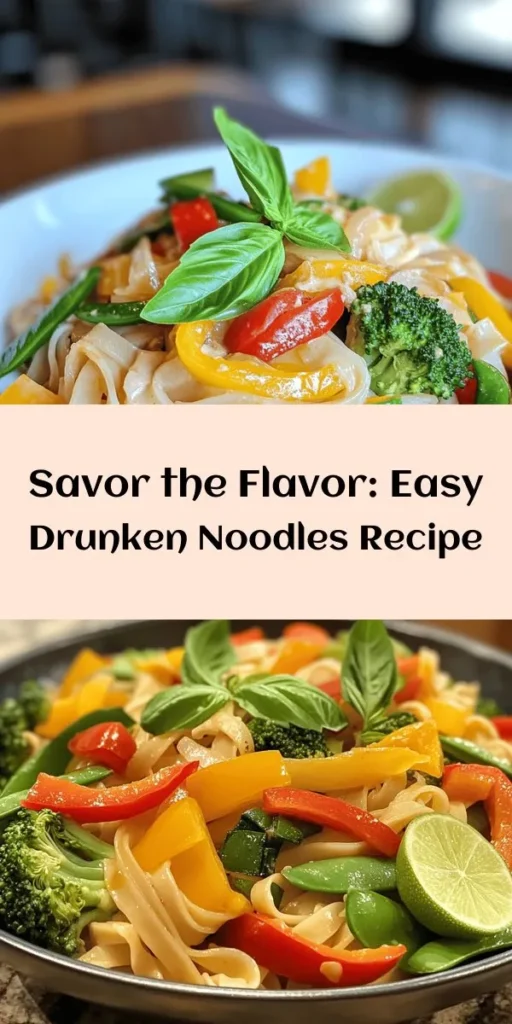Introduction
Drunken Noodles, known as “Pad Kee Mao” in Thai, is a beloved dish that has captured the hearts—and palates—of food enthusiasts around the world. Originating from the vibrant streets of Thailand, this stir-fried noodle dish boasts a perfect balance of bold flavors, fresh vegetables, and aromatic herbs, making it a staple in Thai cuisine. With its origins steeped in the lively culture of Thailand, Drunken Noodles has become synonymous with satisfying cravings for spicy, savory, and slightly sweet flavors, all wrapped up in a delightful noodle experience.
The popularity of Drunken Noodles can be attributed to its unique combination of taste and texture. The wide rice noodles are stir-fried to perfection, absorbing the rich flavors of the sauces and seasonings. Whether enjoyed in a bustling street market or a cozy Thai restaurant, this dish brings a sense of comfort and excitement that is hard to resist. As a versatile recipe, it accommodates various protein options, making it appealing to both meat lovers and vegetarians alike.
In this article, you will embark on a culinary adventure that delves into the heart of Drunken Noodles. You will learn about the key ingredients that contribute to its distinctive flavor profile, explore the cultural significance of this dish, and follow along with a detailed recipe and cooking techniques that will empower you to recreate this Thai favorite in your own kitchen. Get ready to discover the joy of making Drunken Noodles Delight—an experience that promises to be as delicious as it is educational.
Understanding Drunken Noodles
The name “Drunken Noodles” is as intriguing as the dish itself. While there are many theories regarding its origin, one popular belief is that the dish was created for those seeking a hearty meal after a night of revelry, hence the term “drunken.” In this context, it serves as a comforting remedy, harmonizing the effects of a night out with its rich flavors and satisfying texture. The dish is traditionally spiced with fresh Thai bird’s eye chilies, which add a fiery kick that complements the other ingredients.
Drunken Noodles also reflect the regional diversity of Thai cuisine. Different parts of Thailand may offer their own variations of the dish, emphasizing local ingredients and preferences. For instance, some may incorporate seafood, while others might lean towards a vegetarian approach. The beauty of Drunken Noodles lies in its adaptability, allowing cooks to tailor it to their tastes and dietary needs.
At its core, Drunken Noodles is a celebration of fresh ingredients and vibrant flavors. The dish typically features wide rice noodles, which provide a chewy texture that pairs well with a variety of sauces and toppings. The combination of fresh vegetables, aromatics, and proteins creates an enticing medley of colors and tastes, making every mouthful a delightful experience.
The Ingredients Breakdown
To fully appreciate the flavors and textures of Drunken Noodles, it’s essential to understand the key ingredients that come together to create this dish. Below is a detailed breakdown of each component that contributes to the delightful experience of Drunken Noodles.
Rice Noodles
At the heart of Drunken Noodles are the rice noodles, typically wide and flat. These noodles are essential for achieving the dish’s characteristic texture, as they absorb the flavors of the sauces while remaining tender yet chewy. When preparing Drunken Noodles, it’s recommended to use fresh rice noodles if available, as they offer the best texture. However, dried rice noodles can also be used as an alternative; simply soak them in hot water according to package instructions before stir-frying.
Aromatics
Aromatics play a crucial role in elevating the flavor profile of Drunken Noodles. Key ingredients such as garlic, shallots, and Thai bird’s eye chili contribute layers of complexity to the dish. Garlic and shallots provide a savory base, while the bird’s eye chili adds a vibrant heat that is characteristic of many Thai dishes. The balance of these aromatics creates a fragrant foundation that enhances the overall taste.
Vegetables
In addition to rice noodles and aromatics, the inclusion of fresh vegetables adds not only color but also nutrition to Drunken Noodles. Common choices include bell peppers, broccoli, and snap peas. These vegetables not only provide a crunchy texture but also complement the dish with their vibrant hues. Feel free to experiment with seasonal vegetables or whatever you have on hand, as this dish is incredibly versatile.
Sauces and Seasonings
A crucial element in achieving the signature taste of Drunken Noodles lies in the sauces and seasonings used. A well-balanced combination of oyster sauce, soy sauce, fish sauce, sugar, and black pepper creates a harmonious blend of savory, sweet, and umami flavors. The oyster sauce lends a rich depth, while soy sauce adds saltiness. Fish sauce contributes a unique brininess that is quintessential in Thai cuisine. A pinch of sugar helps to balance the flavors, ensuring that each ingredient shines through.
Protein Options
Drunken Noodles can be customized with a variety of protein options, catering to different preferences. Popular choices include shrimp, chicken, and tofu. Each protein brings its own unique flavor and texture to the dish. For seafood lovers, shrimp offers a delightful sweetness that pairs beautifully with the other ingredients. Chicken provides heartiness, while tofu serves as a versatile vegetarian option, soaking up the surrounding flavors beautifully. Choose your preferred protein or mix and match to create a personalized version of this beloved dish.
Step-by-Step Cooking Instructions
Now that we’ve explored the ingredients that make Drunken Noodles so special, it’s time to dive into the cooking process. Here, we’ll guide you through the essential steps to prepare this delightful dish, starting with the preparation of the rice noodles.
Preparing the Noodles
1. Soak the Rice Noodles: If you’re using dried rice noodles, begin by soaking them in hot water for about 30-40 minutes or until they are soft but still slightly firm. Drain the noodles and set them aside. If using fresh rice noodles, simply separate them gently.
2. Prepare for Stir-Frying: Before you start the stir-frying process, gather all your ingredients and have them prepped and ready to go. This includes slicing your vegetables, mincing the garlic and shallots, and cutting your protein into bite-sized pieces. Having everything prepared ensures a smooth cooking experience since stir-frying is a quick process.
Heating the Oil
1. Choose the Right Pan: Use a large wok or a heavy-bottomed skillet for stir-frying. The wide surface area allows for even cooking and proper heat distribution.
2. Heat the Oil: Pour a few tablespoons of neutral oil, such as vegetable or peanut oil, into the hot pan. Heat the oil over medium-high heat until it shimmers. Proper oil temperature is crucial for achieving that signature stir-fried flavor and ensuring that the ingredients cook evenly.
As you progress through the steps of preparing Drunken Noodles, remember to embrace the vibrant flavors and colorful ingredients that make this dish a true representation of Thai cuisine. In the next section, we will explore the remaining steps to complete your Drunken Noodles Delight, guiding you toward a delicious, homemade experience that will transport your taste buds straight to Thailand. Stay tuned for the exciting continuation of this culinary journey.

Sautéing Aromatics
To achieve the rich and complex flavors that define Drunken Noodles, the sautéing of aromatics is a critical first step. Start by finely chopping garlic, shallots, and fresh chili peppers. The key to maximizing flavor extraction lies in your cooking technique. Use a large skillet or wok over medium-high heat, and add a splash of oil—preferably vegetable or peanut oil, which can withstand high temperatures without smoking. Once the oil is shimmering, introduce the garlic and shallots first. Sauté them for about 30 seconds until they become fragrant and translucent, but be careful not to let them brown too much, as this can impart a bitter taste.
Next, add the chopped chili peppers. The heat level is adjustable based on your preference; for a milder dish, you can remove the seeds from the peppers. Sauté these aromatics together for another minute, stirring constantly to prevent burning. This process not only releases the essential oils from the garlic and shallots but also allows the flavor of the chili to meld into the oil, creating a flavorful base for your Drunken Noodles.
Incorporating Protein
Choosing and cooking the right protein is essential for achieving tenderness and ensuring that your Drunken Noodles are satisfying and flavorful. Common protein options include chicken, shrimp, or tofu for a vegetarian option. If using chicken or shrimp, slice them into bite-sized pieces to promote even cooking. For tofu, press it to remove excess moisture, then cut it into cubes.
Before adding protein to the pan, ensure that your aromatics are well-cooked. Increase the heat to high and add your chosen protein to the pan, making sure not to overcrowd it. This will help achieve a nice sear which enhances flavor. Cook the protein for 2-3 minutes until it’s just cooked through, stirring occasionally. If using tofu, allow it to brown on each side for about 4-5 minutes for a delicious texture. Season lightly with salt and pepper while cooking to enhance its flavor. This step is crucial as it allows the protein to absorb the flavors of the aromatics, enriching the overall dish.
Adding Vegetables
The addition of vegetables not only provides a nutritious balance to the dish but also adds texture and color. Select a variety of crisp vegetables such as bell peppers, carrots, snap peas, or broccoli. The timing of adding these vegetables is crucial to maintaining their crunch. After the protein is cooked, add the harder vegetables like carrots and bell peppers first, allowing them to sauté for about 2 minutes. Then, add softer vegetables like snap peas or broccoli and sauté for an additional 1-2 minutes.
To retain the vibrant colors and essential nutrients, keep the cooking time short. Stir-frying over high heat will help achieve that perfect crunch while ensuring the vegetables are evenly coated in the flavors of the aromatics and protein. Remember, you want the vegetables to be tender yet still crisp, as they will add a satisfying bite to your Drunken Noodles.
Mixing in the Noodles
Once your protein and vegetables are sautéed to perfection, it’s time to incorporate the noodles. For Drunken Noodles, wide rice noodles are traditionally used. It’s essential to prepare these noodles according to package instructions, typically soaking them in hot water until they are pliable but not fully cooked, as they will continue to cook in the pan.
When mixing the noodles into the skillet, gently toss them with the protein and vegetables using two spatulas or tongs. The key here is to avoid breaking the noodles. A gentle folding motion will help combine all the ingredients without damaging the delicate noodles. If necessary, you can add a splash of water or broth to help loosen the noodles and facilitate mixing.
Creating the Sauce Mixture
The sauce is the heart of Drunken Noodles, providing depth and balance to the dish. A typical sauce consists of soy sauce, oyster sauce, fish sauce, and a hint of sugar. To prepare the sauce, combine the following ingredients in a small bowl:
– 2 tablespoons soy sauce
– 1 tablespoon oyster sauce
– 1 tablespoon fish sauce
– 1 teaspoon sugar (or to taste)
– 1 tablespoon dark soy sauce (for color and depth)
Whisk these ingredients together until the sugar dissolves. Once your noodles, protein, and vegetables are well mixed in the skillet, pour the sauce mixture over them. Toss everything together for an additional 2-3 minutes over medium-high heat, allowing the noodles to absorb the sauce. This step is vital, as it ensures every element of the dish is infused with the rich, savory flavors of the sauce, creating that signature taste of Drunken Noodles.
Finishing Touches
To elevate the dish further, the addition of fresh herbs and citrus is essential. Just before serving, remove the pan from heat and toss in a generous handful of fresh Thai basil. The aromatic oils will release upon contact with the heat, imparting a fragrant aroma that complements the dish beautifully. Additionally, squeeze fresh lime juice over the noodles for a burst of acidity that brightens the flavors and balances the richness of the sauce.
Serve your Drunken Noodles hot, garnished with additional Thai basil or sliced lime wedges for an appealing presentation. This final touch not only enhances the dish visually but also invites diners to adjust the flavor to their liking.
The Flavors of Drunken Noodles
Drunken Noodles are celebrated for their bold flavors, which beautifully balance spice and sweetness. The interplay of salty soy sauce and sweet sugar creates a harmonious flavor profile that is characteristic of Thai cuisine. Adjusting the levels of each ingredient can offer a personalized touch; for instance, adding more chili will increase the heat, while reducing sugar can create a more savory dish.
Fresh herbs play a pivotal role in enhancing the dish’s aroma and overall flavor. Thai basil, with its distinct scent and slightly sweet flavor, is often preferred over regular basil due to its unique profile. Its addition not only elevates the dish but also provides a traditional touch that is essential to authentic Drunken Noodles.
Customization is not only encouraged but celebrated. Feel free to experiment with different proteins, vegetables, or even add unique ingredients such as pineapple or cashews for an unexpected twist. Tailoring the recipe to your taste preferences can make the dish even more enjoyable.
Serving Suggestions
Presentation is key when serving Drunken Noodles. To create a visually appealing plate, consider garnishing with additional fresh basil leaves, finely sliced red chili for a pop of color, or a sprinkle of sesame seeds. A side of fresh lime wedges not only adds visual interest but also allows guests to adjust the acidity to their taste.
Pairing your Drunken Noodles with complementary side dishes can enhance the overall dining experience. Consider serving them alongside a light cucumber salad or a side of spring rolls, which offer a refreshing contrast to the robust flavors of the noodles. For beverages, a chilled Thai iced tea or a light beer can balance the spiciness of the dish.
When it comes to storage, Drunken Noodles can be kept in an airtight container in the refrigerator for up to three days. To reheat, simply stir-fry them in a pan for a few minutes, adding a splash of water or broth to prevent drying out. This method helps to retain the flavors and textures, ensuring that leftovers remain delicious.
Conclusion
Making Drunken Noodles is not just about preparing a meal; it’s about creating an experience that brings people together. The joy of sharing a plate of these flavorful noodles, whether at a dinner party or a casual family meal, embodies the spirit of Thai cuisine—vibrant, communal, and full of life.
As you explore this recipe, remember that it offers a framework to build upon. Embrace the opportunity to experiment with different ingredients and flavors while honoring the traditional roots of this delightful dish. Each batch of Drunken Noodles you create can tell a new story, inviting friends and family to the table to enjoy the rich, aromatic flavors of Thailand. Happy cooking!



